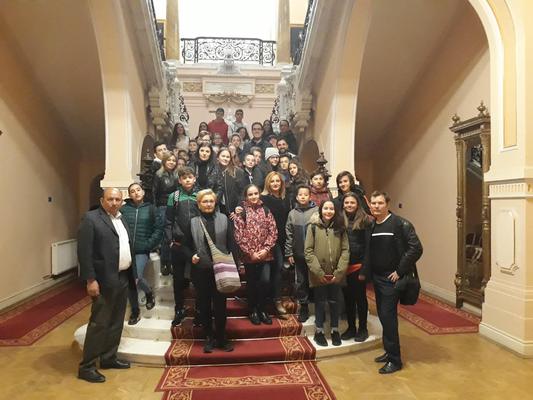
Romania - Grozesti - 31st March to 6th April 2019
Environmental Club
Goal: To develop children’s identity
Monday was a long day in Romania. The morning began at the Grozesti school, about 60 km from Craiova. It is a rural school surrounded by houses built with clay. It was fun to see children playing on the grass and getting along in merry-go-rounds and swings in the school playground. We started with a basic vocabulary exchange of each language, in a fast course in which everyone was simultaneously teachers and students, and an ecological fashion show followed by a home made lunch. In the afternoon we had a live class of the Romanian architecture of the area. This was also the birthday of Maks from Poland and Rui from Portugal and all partners were singing the birthday song in English and also in each language. Back to Craiova there was still time to visit the magnificent botanical garden, wouldn’t this be the environment club!
We spent Tuesday in Craiova. The Museum of Art, now a museum, in the past a royal palace, has its rooms organised in chronological order throughout the history of Romanian art. Actually, through art we could learn a lot about their way of life. The wars fought, the way lovers expressed their emotions, the traditions in the royal court and the natural environment that influenced all these events, namely the cold winters in Romania that were crucial for stopping the Turkish to getting further into Romanian territory. Here is also the first sculpture believed to represent modern sculpture. In the public library of Craiova, besides visiting its rooms, we could watch parts of the Brazilian documentary “Wasteland”, to raise environmental awareness. The Museum of Romanian History was the last stop where we learned about historical facts since prehistoric times until the 1950’s. A very quick but interesting approach that, once again was a great way of learning out of the school walls.
The Museum of Popular Architecture in Târgu Jiu was a good way to see how people were more respectful towards nature in the past. Only natural elements were used in the buildings: wood for structure, windows and shingles on the roof; clay and straw for good insulation for building the walls. This is what we call now sustainability. In this Wednesday afternoon the visit to the Arts High School - Liceul de Arte Constantin Brailoui - was a surprise. Besides being talented, these students are impressively professional. They played Beethoven, Chopin and other classic composers in a way that caught the young audience interest. The end of the mini concert made the feet move under the chairs to the rhythm of traditional Romanian music performed at parties and weddings. Simply amazing! A gift! But before going back to Craiova we could still visit the Arts class with incredible drawings and paintings, as well as sketches of houses that seemed like architects’ blueprints.
Spending Thursday in Severin was very exciting. In the Iron Gate Museum, besides visiting the ruins of Roman and medieval times, we also had a workshop where our pictures were taken and used to represent ourselves as part of the natural environment, as a way of raising our environmental consciousness. In the afternoon we could observe a bit more of history and the natural landscape on board a cruise boat on the Danube river. Three hours were enough to have classes about the history of Romania, in which Daltians and Romans fought to own the territory, symbolised on the wall by the face of Decebald. Then a lesson about geography followed by acknowledging the Serbian territory on the other margin of the Danube. Also geology concepts about the formation of the Carpathian Mountains and the unique Danube Boilers were presented. Meanwhile everybody had a good time socialising and sharing the cultural habits on each other’s countries.
Friday was an easy day. A short stroll to the Natural Science Museum and we were immersed in the environment that we could observe throughout the week on our journeys through this area of Romania. The prehistoric animals found around the area, the fauna and flora and the geological heritage are all well represented in this small but well organised museum. Further on we entered the Ethnographic Museum - Casa Bäniei - where the food, clothes and tapestries are the window to the arts, crafts and habits of the Romanian people. Still before lunch we were fortunate enough to visit the school that is recognised as the best in Craiova. The key to its success might be that the board of education holds regular meetings with the students to discuss the school projects and answer students' questions, engaging every single one to the process of learning. By the end of the day all the teams had a farewell evening together to enjoy the last moments of socialising. Chatting, summing up the results of the week, playing cards or even dancing a bit...